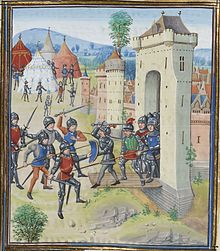
Back Siège d'Aiguillon French Aiguillon ostroma Hungarian Cerco de Aiguillon Portuguese Asediul asupra Aiguillon Romanian 艾吉永圍城戰 Chinese
| Siege of Aiguillon | |||||||||
|---|---|---|---|---|---|---|---|---|---|
| Part of the Edwardian Phase of the Hundred Years' War | |||||||||
 A medieval town under assault. A miniature from a chronicle by Jean Froissart. | |||||||||
| |||||||||
| Belligerents | |||||||||
|
|
| ||||||||
| Commanders and leaders | |||||||||
|
|
| ||||||||
| Strength | |||||||||
| 15,000–20,000 | ||||||||
| Casualties and losses | |||||||||
| Unknown | Unknown | ||||||||
The siege of Aiguillon, an episode in the Hundred Years' War, began on 1 April 1346 when a French army commanded by John, Duke of Normandy, laid siege to the Gascon town of Aiguillon. The town was defended by an Anglo-Gascon army under Ralph, Earl of Stafford.
In 1345 Henry, Earl of Lancaster, was sent to Gascony in south west France with 2,000 men and large financial resources. In 1346 the French focused their effort on the south west and, early in the campaigning season, an army of 15,000–20,000 men marched down the valley of the Garonne. Aiguillon commands both the Rivers Garonne and Lot, and it was not possible to sustain an offensive further into Gascony unless the town was taken. Duke John, the son and heir apparent of Philip VI, laid siege to the town. The garrison, some 900 men, sortied repeatedly to interrupt the French operations, while Lancaster concentrated the main Anglo-Gascon force at La Réole, some 30 miles (48 km) away, as a threat. Duke John was never able to fully blockade the town, and found that his own supply lines were seriously harassed. On one occasion Lancaster used his main force to escort a large supply train into the town.
In July the main English army landed in northern France and moved towards Paris. Philip VI repeatedly ordered his son, Duke John, to break off the siege and bring his army north. Duke John, considering it a matter of honour, refused. By August, the French supply system had broken down, there was a dysentery epidemic in their camp, desertion was rife and Philip VI's orders were becoming imperious. On 20 August the French abandoned the siege and their camp and marched away. Six days later the main French army was decisively beaten in the Battle of Crécy with very heavy losses. Two weeks after this defeat, Duke John's army joined the French survivors.
© MMXXIII Rich X Search. We shall prevail. All rights reserved. Rich X Search